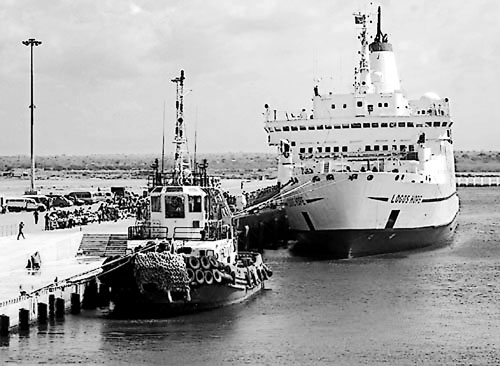Ranatunga wants to run ECT, Hambantota ports

SLPA Chairman Dhammika Ranatunga.
T0he government and the Sri Lanka Ports Authority (SLPA) have differed opinions on how to run the ports to achieve profitability, not only pertaining to the Hambantota port deal with the Chinese firm but also with the new East Container Terminal (ECT) issue.
The ECT is urgently required to overcome a drop in volumes from the Jaya Container Terminal (JCT) as it is expected to assist in beefing up the profits at the SLPA.
âWe are going to have a drop in volumes in JCT until we take over ECT and run it,â SLPA Chairman Dhammika Ranatunga, brother of Ports Minister Arjuna Ranatunga, said in an interview with the Business Times on Monday.
He noted that in view of the lesser draft available at the South Asia Gateway Terminal (SAGT) and JCT they could only service feeder vessels whereas the ultra large vessels (ULVs) would go to the Colombo International Container Terminal (CICT).
In this respect, he pointed out that the ECT, in which there is still no agreement on whether to invite a private operator or for the SLPA to run it, should be operational immediately as it was planned to have the equipment ready at the terminal and commence work by March this year.
But industry analysts blame inefficiency, under performance and a lack of marketing that could ideally boost the JCT volumes and turnover.
JCT although unable to attract the ULVs like the CICT, is similar to the John Keells Holdings-run SAGT which has shown growth and profitability. Moreover, the state run terminal capacity is 50 per cent more than the private operator.
However, the SLPA has run into problems with the Cabinet Committee on Economic Management (CCEM), about a month back, having proposed to introduce conditions to suit a single port operator which the relevant authorities said would be out of line if pursued.
In this regard, the CCEM has sought the advice of the Attorney General (AG) after the conclusion of the EOI of the ECT.
Mr. Ranatunga explained that they had submitted two cabinet papers on ECT and believed there was a âdifferent thinkingâ by the government on how the ECT should be operated.
He noted that SLPA officials had consultations with the AGâs department and the staff had stated their position on the issue.
Five companies were shortlisted and the SLPA had proposed the purchase of 12 RTGs and three gantry cranes at a cost of US$65 million but there had been no response so far.
The government believes that unless the terminal is privatised this cannot be operated efficiently; in fact some in the industry also note that though the SLPA in the past had proved they were capable of beating the private sector given the right management, nepotism would not be the right way to do it. Port unions have been vociferous against the Ranatunga brothers alleging corruption and mismanagement which has been strenuously denied by the brothers. In fact Prime Minister Ranil Wickremesinghe too had to intervene at one stage when workers were denied their New Year bonuses for 2015.
Business plan
SLPA Chairman Ranatunga noted that they had a business plan worked out for the JCT by ensuring that increased numbers of feeder vessels would call at the terminal.
Referring to the JCT, he explained, âItâs not losing business. Itâs a temporary change in pattern. If a deep draft terminal attracts feeder vessels thatâs due to availability â but our model is to allow big vessels to those two and feeders to the JCT and SAGT.â
JCT earnings in 2016 were at Rs.12, 797 million, he said. But the terminal is currently losing volumes with a drop of 21 per cent in TEUs or containers handled at the state run terminal for the month of February compared to the same period last year. January was also down by 21 per cent compared to the previous year.
Container handling in January at SAGT increased by 29 per cent in January this year compared to last year and CICT increased by 23 per cent. February also showed an increase by 20 per cent of container vessels handled at the SAGT and CICT increased by 24 per cent for the same month.
The JCT is planned to upgrade and replace its existing old equipment and develop the terminal, Mr. Ranatunga said.
As part of the budget review the SLPA is planning to also obtain an extension of the berth at the JCT and replace cranes.
 China deal
China deal
Mr. Ranatunga said that the SLPA had raised about 30 concerns on matters like the valuation method on the Rs.2500 per perch proposed as opposed to the current figure of $50,000 per hectare.
The plan by the SLPA for the Hambantota port âwas differentâ he said adding that there were two RFPs floated under the previous government and after Minister Arjuna Ranatunga took office, the latter being for an industrial zone and bunkering.
Mr. Ranatunga noted that the concessionary agreement or the terms of handing over the port to the Chinese company were changed four times.
He also explained that some of the concerns that they had were relating to the port security as it was SLPA security that was manning the port and not the Sri Lanka Navy (SLN). The latter is called in only at certain instances to engage in operations along with the SLPA security.
Moreover, he noted that as part of the commercial aspect of the land a minimum of 1000 hectares of land is being allocated on lease for $55 million per year.
âWe asked for a 35 year lease and the terminal operation on a 65 year period,â he said, adding that the agreement does not entail a non performance policy.
He pointed out that they wanted to operate the port without handing over the port to a third party.
Asked whether the SLPA would operate as a regulator, he pointed out that âthese are vague wordsâ, adding that he does not know about such a policy.
The SLPA can work the Hambantota port and the ECT, Mr. Ranatunga said adding that âIâm confident because I have done business around the world.â
Another Chinese company was said to have come about a year ago to carry out a feasibility study, sent by the government, on building a dockyard at the Hambantota port, the Chairman said.
They were present for a period of about three months and were here following an RFP was floated for the industrial zone.
East port and South Marina
The Trincomalee port development is being worked out with the Asian Development Bank (ADB), Mr. Ranatunga said adding that this report would be released by mid April.
Possibilities are being floated for a lose cargo and an industrial zone with certain areas allocated for leisure, he explained. He also said that the refineries and an LNG could operate over there.
The rail link from the port would be used to transport goods out of the port to the areas like an investment zone which is part of the master plan worked out for the East coast.
Meanwhile, the Galle Marina is being proposed for development at a cost of $40 million which has been submitted to Cabinet. The CCEM had proposed to follow a new method in awarding the contract by adopting the Swiss Challenge process, Mr. Ranatunga said.
(According to Wikipedia, a Swiss challenge is a form of public procurement in some jurisdictions which requires a public authority – usually an agency of government – which has received an unsolicited bid for a public project or services to be provided to government, to publish the bid and invite third parties).
He pointed out that the investor is expected to submit the proposal next week and in one monthâs time the other interested parties could bid for it. Operations on the marina are being scheduled within the next two months, the Chairman said.
Worker motivation
Mr. Ranatunga explained that they had reduced idle time by 40 per cent at the port and increased the turnaround time for offloading containers from vessels from 23 movements per hour to 28 movements per hour.
Currently the management at the SLPA is said to be developing a new human resources plan to improve efficiency and bring in innovation to the system.
Mr. Ranatunga said that they needed to restructure the recruitment procedures and by mid this year the completed HR master plan would take effect.
He explained that workers were aware of the value of the ECT terminal noting that âemployees are concerned because we wonât get as much revenue as we would like toâ.
Workers have been constantly carrying out protests against the âsaleâ of the ECT and other issues pertaining to management decisions.


